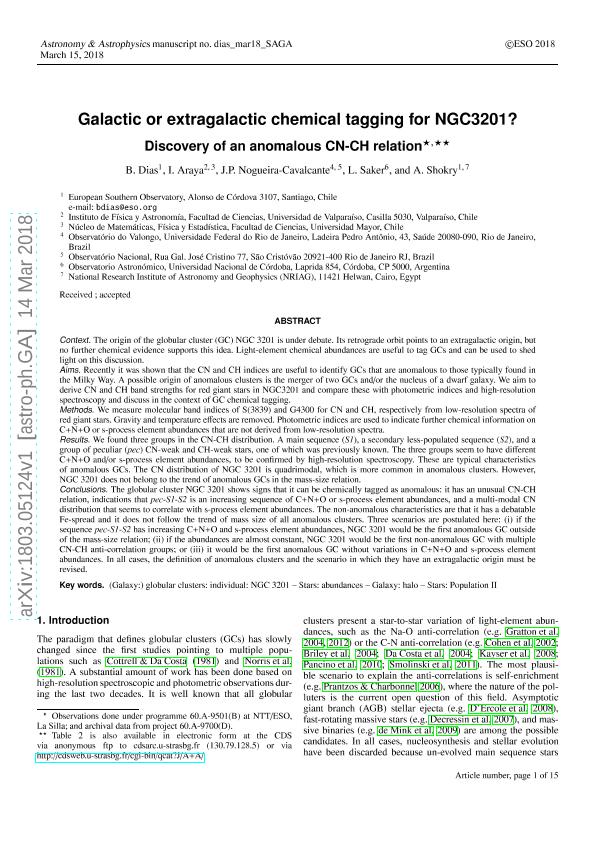Artículo
Galactic or extragalactic chemical tagging for NGC 3201?: Discovery of an anomalous CN-CH relation
Fecha de publicación:
06/2018
Editorial:
EDP Sciences
Revista:
Astronomy and Astrophysics
ISSN:
0004-6361
e-ISSN:
1432-0746
Idioma:
Inglés
Tipo de recurso:
Artículo publicado
Clasificación temática:
Resumen
The origin of the globular cluster (GC) NGC 3201 is under debate. Its retrograde orbit points to an extragalactic origin, but no further chemical evidence supports this idea. Light-element chemical abundances are useful to tag GCs and can be used to shed light on this discussion. Aims. Recently it was shown that the CN and CH indices are useful to identify GCs that are anomalous to those typically found in the Milky Way. A possible origin of anomalous clusters is the merger of two GCs and/or the nucleus of a dwarf galaxy. We aim to derive CN and CH band strengths for red giant stars in NGC3201 and compare these with photometric indices and high-resolution spectroscopy and discuss in the context of GC chemical tagging. Methods. We measure molecular band indices of S(3839) and G4300 for CN and CH, respectively from low-resolution spectra of red giant stars. Gravity and temperature effects are removed. Photometric indices are used to indicate further chemical information on C+N+O or s-process element abundances that are not derived from low-resolution spectra. Results. We found three groups in the CN-CH distribution. A main sequence (S1), a secondary less-populated sequence (S2), and a group of peculiar (pec) CN-weak and CH-weak stars, one of which was previously known. The three groups seem to have different C+N+O and/or s-process element abundances, to be confirmed by high-resolution spectroscopy. These are typical characteristics of anomalous GCs. The CN distribution of NGC 3201 is quadrimodal, which is more common in anomalous clusters. However, NGC 3201 does not belong to the trend of anomalous GCs in the mass-size relation. Conclusions. The globular cluster NGC 3201 shows signs that it can be chemically tagged as anomalous: it has an unusual CN-CH relation, indications that pec-S1-S2 is an increasing sequence of C+N+O or s-process element abundances, and a multi-modal CN distribution that seems to correlate with s-process element abundances. The non-anomalous characteristics are that it has a debatable Fe-spread and it does not follow the trend of mass size of all anomalous clusters. Three scenarios are postulated here: (i) if the sequence pec-S1-S2 has increasing C+N+O and s-process element abundances, NGC 3201 would be the first anomalous GC outside of the mass-size relation; (ii) if the abundances are almost constant, NGC 3201 would be the first non-anomalous GC with multiple CN-CH anti-correlation groups; or (iii) it would be the first anomalous GC without variations in C+N+O and s-process element abundances. In all cases, the definition of anomalous clusters and the scenario in which they have an extragalactic origin must be revised.
Archivos asociados
Licencia
Identificadores
Colecciones
Articulos(CCT - CORDOBA)
Articulos de CTRO.CIENTIFICO TECNOL.CONICET - CORDOBA
Articulos de CTRO.CIENTIFICO TECNOL.CONICET - CORDOBA
Citación
Dias, B.; Araya, I.; Nogueira-Cavalcante, J. P.; Saker, Leila Yamila; Shokry, A.; Galactic or extragalactic chemical tagging for NGC 3201?: Discovery of an anomalous CN-CH relation; EDP Sciences; Astronomy and Astrophysics; 614; A146; 6-2018; 1-15
Compartir
Altmétricas




